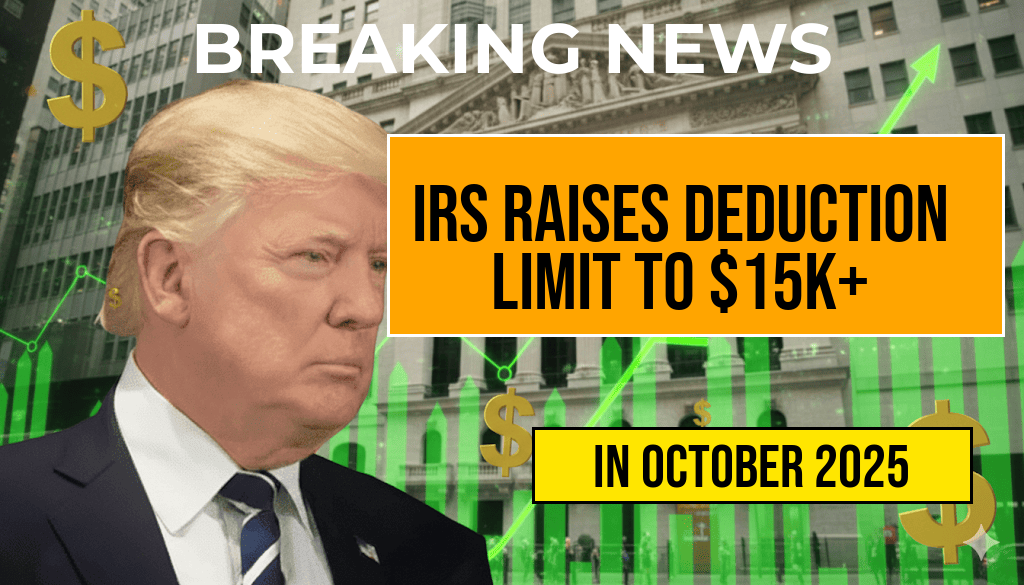IRS Announces Significant Inflation Adjustments for 2025: Single Filers Can Deduct Over $15,000
The Internal Revenue Service (IRS) has released its annual inflation adjustments for the 2025 tax year, providing substantial benefits for individual taxpayers. Notably, single filers will have a new standard deduction of over $15,000, marking a significant increase from previous years. This adjustment could enable many taxpayers to reduce their taxable income substantially, potentially saving upwards of $1,650 or more, depending on their tax bracket. As inflation continues to influence the cost of living and income levels, these adjustments aim to reflect economic realities while offering tax relief to millions.
The updated figures underscore the IRS’s ongoing efforts to align tax thresholds with inflationary trends, which can impact deductions, credits, and overall tax liability. For taxpayers, understanding these changes is crucial for effective tax planning and ensuring compliance with new limits and allowances. With these adjustments, the government aims to balance inflation pressures with fiscal responsibility, providing relief without significantly impacting revenue collections.
Understanding the 2025 Inflation Adjustments
The IRS adjusts key tax parameters annually based on the Consumer Price Index (CPI). For 2025, the inflation adjustments translate into larger standard deductions, higher income thresholds for various tax brackets, and increased limits on retirement contributions and other deductions. The increase in the standard deduction for single filers is particularly noteworthy, rising to over $15,000—a jump from approximately $13,850 in 2023.
These adjustments are designed to reflect the rising costs faced by taxpayers, reducing the necessity of itemizing deductions for many. For single filers, the increased deduction means a lower taxable income, which can significantly reduce their overall tax bill, especially for those with moderate incomes.
Key Tax Changes for Single Filers in 2025
- Standard Deduction: Over $15,000 (exact figure to be finalized by IRS)
- Tax Brackets: Adjusted to accommodate higher income thresholds
- Retirement Contribution Limits: Increased to reflect inflation
- Earned Income Tax Credit (EITC): Adjusted thresholds for eligibility
- Child and Dependent Care Credit: Increased limits and phase-out thresholds
The increased standard deduction means that many single filers with incomes below or near this amount can now effectively shield a larger portion of their income from taxation. For those earning around $50,000 annually, this change could result in notable tax savings.
Estimating Tax Savings Based on Income and Tax Rates
The potential savings from these adjustments depend heavily on an individual’s tax rate. For example, a single filer earning $50,000 and taxed at a 20% rate could see a reduction in taxable income of over $15,000, translating to a tax saving of approximately $3,000. However, the actual savings will vary based on other deductions and credits claimed.
To illustrate, here’s an overview of how different tax rates affect potential savings:
| Tax Rate | Potential Tax Savings |
|---|---|
| 10% | $1,500 |
| 12% | $1,800 |
| 22% | $3,300 |
| 24% | $3,600 |
| 32% | $4,800 |
Thus, taxpayers in higher brackets stand to benefit more significantly from the increased deductions. For middle-income earners, this translates into tangible savings that can amount to over $1,500 annually.
Impacts on Tax Planning and Filing Strategies
The inflation adjustments prompt taxpayers to revisit their financial plans and document their deductions meticulously. Some may find it advantageous to shift from itemizing deductions to claiming the standard deduction, especially if their itemized expenses are below the new threshold.
Tax professionals recommend reviewing income and expense projections early in the year to optimize deductions and credits. Additionally, increased contribution limits for retirement accounts such as IRAs and 401(k)s can be leveraged to reduce taxable income further.
The IRS also emphasizes that these adjustments aim to maintain fairness and prevent bracket creep, where inflation pushes taxpayers into higher tax brackets despite no real increase in purchasing power.
Resources for Taxpayers
Taxpayers can access the official IRS release and detailed tables outlining the 2025 inflation adjustments at the [IRS website](https://www.irs.gov). For comprehensive guidance on how these changes impact individual tax situations, consulting with a certified tax professional is advisable.
Further information on tax brackets, deductions, and credits can be found on [Wikipedia’s Taxation in the United States](https://en.wikipedia.org/wiki/Taxation_in_the_United_States), providing context on the broader tax landscape.
As the 2025 filing season approaches, staying informed about these inflation adjustments will help taxpayers maximize their savings and ensure compliance with evolving tax laws.
Frequently Asked Questions
What is the IRS inflation adjustment for single filers in 2025?
The IRS has increased the standard deduction for single filers in 2025 to over $15,000, allowing taxpayers to reduce their taxable income significantly.
How much can single filers potentially save on taxes in 2025?
Based on current tax rates, single filers could save $1,650 or more, depending on their taxable income and applicable tax brackets.
What factors influence the amount of tax savings for single filers?
The tax rate a filer is in, their deductions, and overall taxable income determine the extent of their tax savings in 2025.
Will the IRS inflation adjustment affect other tax credits or deductions?
Yes, the inflation adjustment may impact various tax credits and deductions, potentially increasing or decreasing the overall tax benefits for single filers.
When will the new standard deduction and tax adjustments take effect?
The updated standard deduction and related inflation adjustments will apply to the 2025 tax year, with filings typically due in early 2026.

Leave a Reply